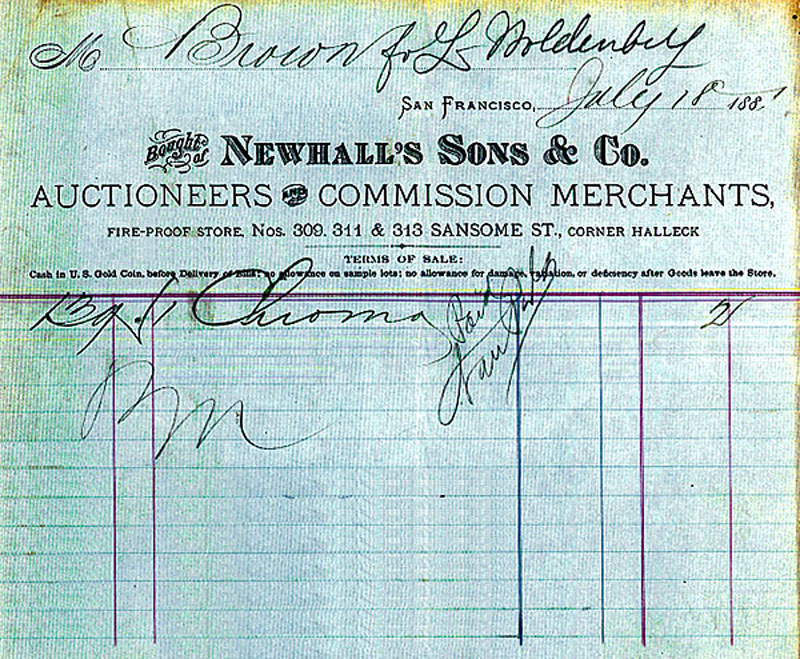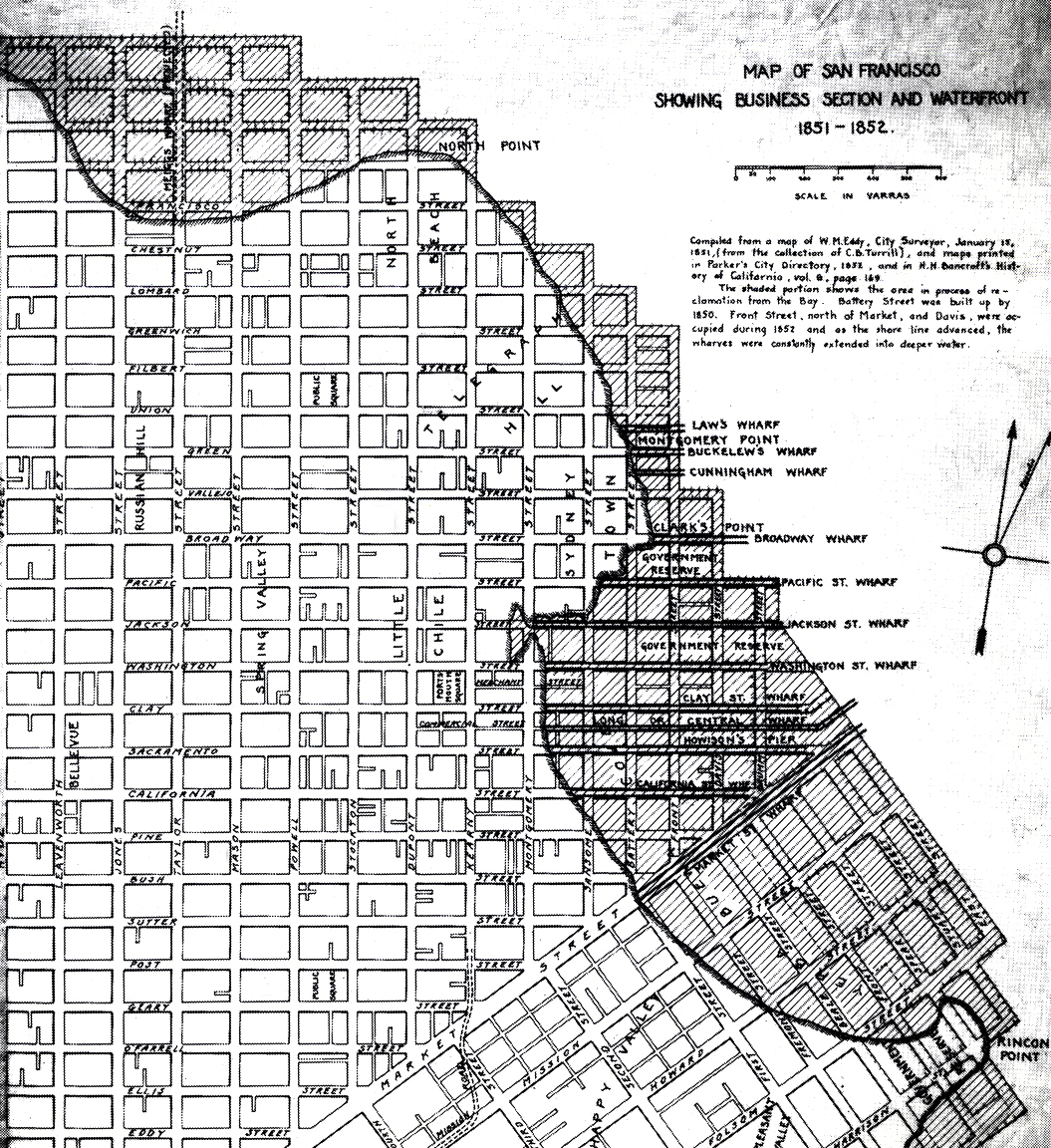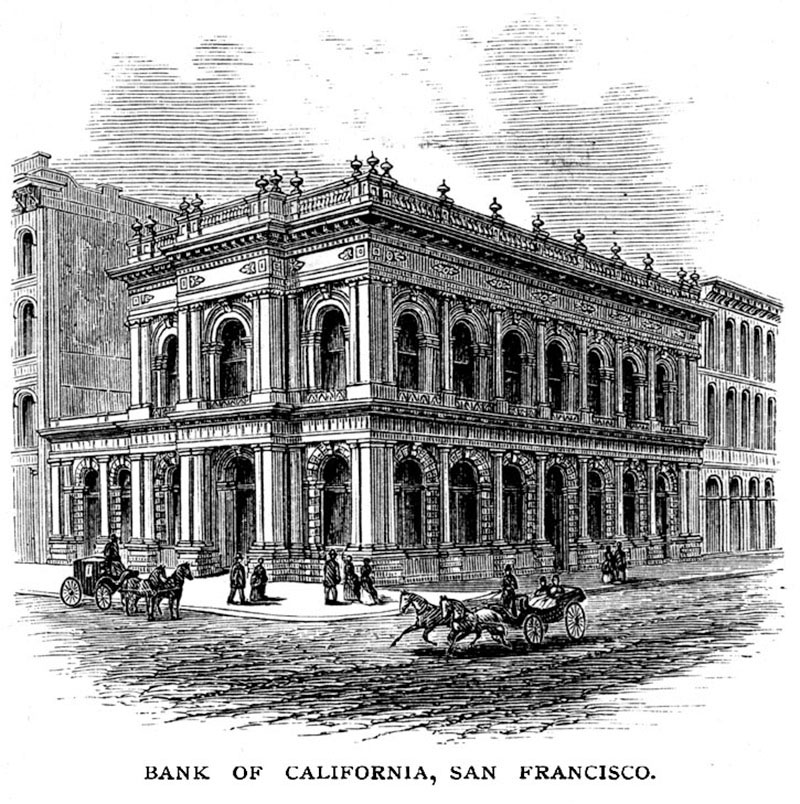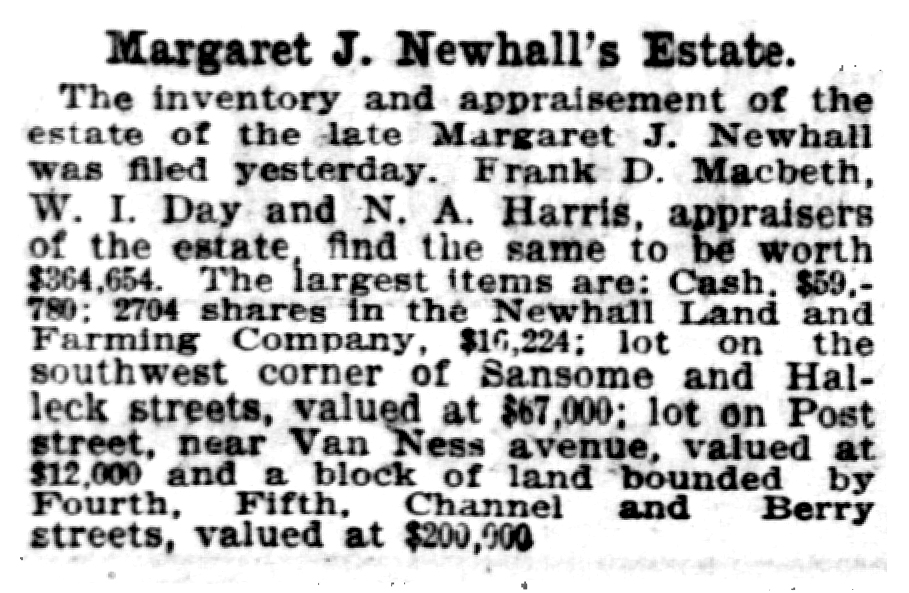|
|
San Francisco, California

This is confusing. It is a billhead from Newhall's Sons & Co. Auctioneers and Commission Merchants, with a hand-written date apparently reading July 18, 1881. Trouble is, as far as anyone knows, Newhall's Sons & Co. wasn't set up until 1883, a year after H.M. Newhall's death. It's possible that the hand-written date is 1887, but that wouldn't make much sense either, in that the company is believed to have lasted just two years. It could be a really poorly scrawled 1884, but judging from the original, it isn't likely. The billhead reads as follows: "Bought of Newhall's Sons & Co., Auctioneers and Commission Merchants, Fire-Proof Store, Nos. 309, 311 & 313 Sansome St., Corner Halleck. Terms of Sale: Cash in U.S. Gold Coin, before Delivery of Bills; no allowance on sample lots; no allowance for damage, variation, or deficiency after Goods leave the Store. Anyway, on with the "official" story ...
H.M. Newhall & Co., Auctioneers and Commission Merchants. If Henry Mayo Newhall had arrived in San Francisco in 1849, we might never had heard of him. He'd have made a quick fortune in the goldfields, or more likely not. There would probably be no town of Newhall — or any other town here for a number of years, if the Southern Pacific Railroad had selected a different route. But Henry didn't arrive in 1849. He arrived in 1850, by which time the most promising claims had been staked. Disappointed, perhaps, but undeterred, Henry recognized a golden opportunity of a different type, and he seized it. Henry was unlike many of the quixotic argonauts. At 25, he knew a trade, and it was in demand. San Francisco was ever in need of commodities as the budding metropolis rose up to replace sleepy Yerba Buena, home to just 800 residents in 1848. Within two years, the population numbered 30,000 to 40,000.[1] A steady stream of ships poured into in the bay to offload their wares. Even when the boom of '49 went bust in '53 and commodity prices fluctuated wildly from week to week or even hour to hour to the benefit or detriment of the seller, there was one constant: The wholesaler always took his cut of the final sales price, whatever it might be. In 1850s San Francisco, the wholesalers were auction houses that sold on consignment and "commission merchants" that functioned as intermediaries between the supercargoes (the person on a ship in charge of its merchandise) and the shop clerks and other buyers. Often both auction house and commission merchant were combined under one roof. Smelling the job security, young Henry took a position in 1850 with the house of Hall, Martin & Co., Auctioneers. It wasn't Henry's first merry-go-round. From age 15 he had been in the wholesale business in Philadelphia, Alabama and Tennessee, working his way up from stock clerk to auctioneer.[2]
About four years older than the two partners who hired him, Henry quickly became Hall and Martin's star seller. Then in May 1851, their auction house on the waterfront at Jackson Street near Montgomery burned down in one of San Francisco's famously frequent fires. Henry Martin quit and sold his share of the business to Henry Newhall, who rebuilt with Almer Hall at the foot of Long (Central) Wharf near Sansome and Commercial streets. A second disastrous fire proved too much for Hall, who left Henry Newhall alone to rebuild a new "fire-proof store."[3] The first two locations — Jackson and Montgomery, Sansome and Commercial — are in the heart of San Francisco's Financial District today. But in 1851, they were beachfront property along Yerba Buena Cove where the ships docked. The shoreline was very different prior to the waterfront reclamation projects that started before 1850 and expanded San Francisco's footprint over the next several decades (see map, inset). Henry's new brick building was located at Sacramento and Battery streets[4], which would have been underwater in 1848 but was shorefront by 1850 when Battery Street was built up. In 1852, Henry erased "Hall, Martin" from his billheads and changed the name of the firm to H.M. Newhall & Co., Auctioneers and Commission Merchants. Now, money was pouring in. Henry branched into insurance and started buying land in San Francisco. During 1860 he moved his firm to a new "fireproof salesroom" a block away on reclaimed land at the southwest corner of Sansome Street and Halleck Avenue[5], and in 1865 he finished construction of a fancy new brick building at that location.[6] Evidently he owned the whole half-block from Halleck south to California Street, because he sold the south half of the property to William C. Ralston's Bank of California, which erected a monumental bank building at California and Sansome. Construction started in 1865, and the bank building was occupied June 27, 1867.[7]
Before the 1850s ran out, Henry started investing in railroads. He bought a stake in a prospective road that actually opened between San Francisco and San Jose in 1863 (as opposed to other speculators' roads that never laid a rail). In 1867, Henry and partners — one being the banker Ralston — formed a second company that ran tracks south to Gilroy. The year 1869 saw the completion of the transcontinental railroad. In 1870, preparing to connect with Los Angeles, the Big Four (Stanford, Crocker, Huntington, Hopkins) snatched up all the little roads and made Henry Newhall a millionaire. Henry invested his windfall in more land — a lot more land. California was now home to 560,000 people, compared to 380,000 ten years earlier.[8] Henry bought old Mexican land-grant ranchos up and down the state, and as a new director of the Southern Pacific Railroad, he was privy to the preferred route. In 1875 he purchased approximately 48,000 acres of the Santa Clarita Valley, deeded a right-of-way to the Southern Pacific for a dollar, and deeded more land to the railroad's development arm to subdivide town lots. Meanwhile, luck turned on Henry's old railroad partner and business neighbor, Ralston, who walked into the ocean during a run on his bank in 1875, never to be seen again. The end came prematurely for Henry, as well. He was riding on his SCV rancho one day in March 1882 when he fell from his horse. He died from his injuries about a week later. Henry's San Francisco auction business was still active, but the business had changed. It had become an outlet for used goods.[9] Overland shipping and the transcontinental telegraph obviated much of the need for barkers at the wharf, which was no longer at the firm's doorstep. Third son Edwin and fifth son Walter, who had been trained in the business, took it over and changed the name to Newhall Sons & Co. It soon folded. They had bigger interests. Following some initial distributions, the entity "H.M. Newhall & Co." became the manager of Henry's remaining estate assets, and in 1883, Henry's widow and five sons organized The Newhall Land and Farming Company to manage the real-estate holdings. The rest, as they say, is ... well, you know. — Leon Worden 2020
1. Cleland, Robert Glass. "From Wilderness to Empire: A History of California 1542-1900." New York: Alfred A. Knopf, 1947, pg. 262 (population figures); commodity price fluctuations at pg. 269. 2. Newhall, Ruth. "A California Legend: The Newhall Land and Farming Company." (Valencia, Calif.): The Newhall Land and Farming Company, 1992, pp. 6-7. 3. Ibid., pp. 11-12. 4. Advertisements in the Daily Alta California newspaper; see, for example, April 22, 1860. 5. Daily Alta California, October 1, 1860. Advertisement announces the move. 6. The year of construction appears atop the building in this engraving, which also shows the relation of the building to Halleck Alley (southwest corner). The address was 309-313 Sansome Street. 7. A sign on the present bank building reads: "The Bank of California opened for business July 5, 1864, at the southwest corner of Washington and Battery streets. In 1865 construction was begun on a new home at California and Sansome (this location) which was occupied June 27, 1867. The bank outgrew these quarters and in January 1906 moved to a temporary location at California and Leidesdorff while the present building was being erected. Construction was about to begin when the earthquake and fire occurred April 18, 1906. Work was resumed after the emergency and the bank returned to this site September 8, 1908." 8. Cleland, ibid., pg. 305. "Now" meaning 1870. 9. Newhall, ibid., pp. 72-73.
LW2050: Image courtesy of Tony Newhall. |
H.M.N. CATEGORIES:
SCV History Moment
Advertisement 1867/1874
Billhead 1870
Billhead 1873
Billhead 1881
Sardines 1920s
Location 2001
|
The site owner makes no assertions as to ownership of any original copyrights to digitized images. However, these images are intended for Personal or Research use only. Any other kind of use, including but not limited to commercial or scholarly publication in any medium or format, public exhibition, or use online or in a web site, may be subject to additional restrictions including but not limited to the copyrights held by parties other than the site owner. USERS ARE SOLELY RESPONSIBLE for determining the existence of such rights and for obtaining any permissions and/or paying associated fees necessary for the proposed use.









